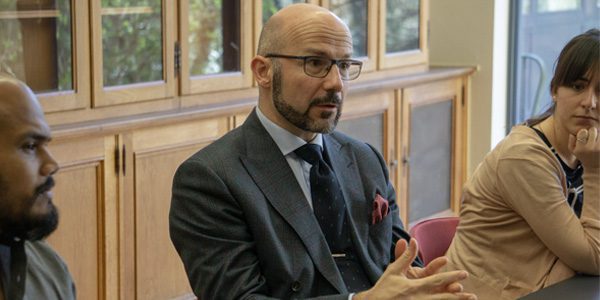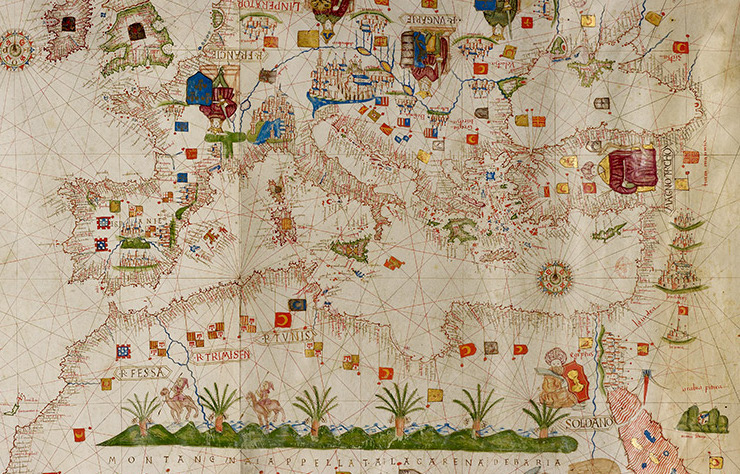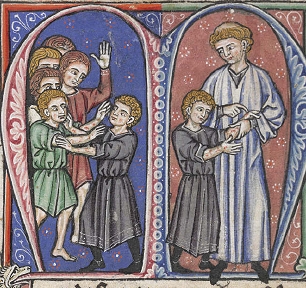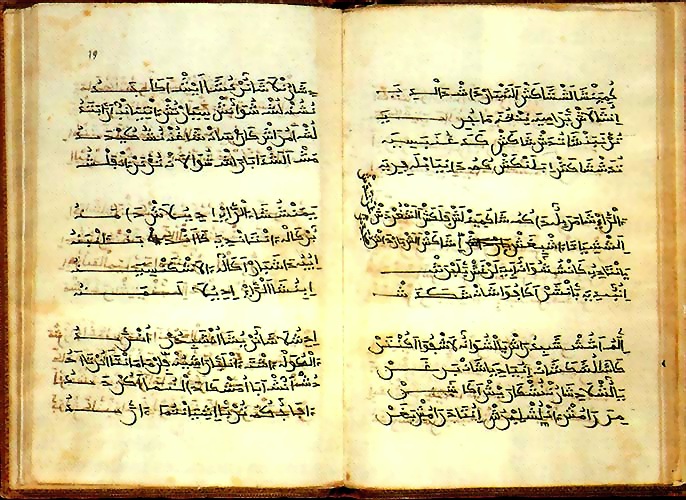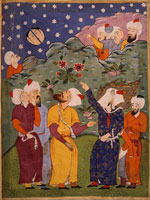In stark contrast to the almost non-reception of the events of 1054 in the literary Byzantine world, discussed here, on the Latin side of the equation, the report of the legation penned by Cardinal Humbert of Silva Candida quickly found its way into various historical chronicles and into theological literature. Two particularly fascinating examples that appear in Patrologia Latina 145 are both published under the name of Peter Damiani, who was, together with Humbert himself, one of the leading members of the papal curia in the mid-eleventh century. Although he would not be elevated to the cardinalate until 1057, under Pope Stephen IX, by the time of Humbert’s legation to Constantinople he was already active in attending various synods and had written the deeply influential Liber Gomorrhianus (addressed to Pope Leo IX). What makes these two works interesting, in light of their purported joint authorship, is that they take views of the azyme conflict (the use of unleavened bread in the celebration of the Eucharist) that are at odds both with each other and with the stance adopted by the Humbertine legation.
The first example is a letter fragment written by Peter Damiani to Henry, the Archbishop of Ravenna, most likely between 1052 and 1058 [1]. The text is eye-opening both for the historian and for the contemporary canonists, so I’ll cite the full text of Fr. Blum’s translation:
…Just as it makes little difference whether at Mass we offer wine or unfermented grape juice, so, it seems to me, it is all the same whether we offer leavened or unleavened bread. For that “living bread that came down from heaven,” just as he wished to manifest himself under the appearance of wheat, he did so also under the form of the vine. “Unless,” he said, “a grain of wheat falls into the ground and dies, it remains a solitary grain.” And again, “I am the real vine.” Therefore, it suffices for me to offer either whatever is made from grain or whatever is produced by the vine. Nor am I too careful to inquire whether the bread was preserved in an immature dough until it could ferment, or also whether the grape juice was kept in a vat until it could turn into what one calls wine. But since it is not my purpose here to discuss these matters, I leave them to be handled by others…. [2]
Peter Damiani here showed himself to be vastly more permissive than most of the mainstream Latin West when it comes to the correct materials for confecting the Eucharist, and even more tolerant than the legates to Constantinople. Humbert, while he tacitly acknowledged that the Greek practice of using leavened bread was permissible, also had a clear preference for the unleavened Latin host. Peter, interestingly, does not here even mention the Greek practice: his letter is entirely within the context of the Latin rite, addressed to an archbishop of an (admittedly Byzantine-influenced) Latin see. This text allows us to see an approach very different from the one that appears in the aforementioned Liber Gomorrhianus. Given the fact that this was a topic of considerable polemics when he wrote the letter, Peter Damiani appears as a moderating, or even progressive, voice in the conflict.
What a surprise, then, when we examine the second text, taken from the Expositio canonis missae. The work as a whole falls into the genre of Mass commentaries, theological treatises that explain the various ritual components of the eucharistic celebration with historical or scriptural parallels and allegory. Fairly early in this treatise, while discussing the phrase “He took bread” (“accepit panem”) the author complains:
Leavened bread should not be offered in the sacrifice, both by reason of deed and by reason of the mystery. As is read in Exodus: “Leaven signifies corruption”, and as the Apostle witnesses: “A little leaven corrupts the whole lump”. But the Greeks, persisting in their error, celebrate [the Eucharist] from leaven. [3]
Now present is a direct mention of the conflict with the Greeks, using scriptural references that were first applied to the debate by the Humbertine legation. And gone is the tolerance of the previous passage, in which the matter of the Eucharist – so long as it comes from grapes and wheat – is a matter of indifference. Instead, for the author, the use of leavened bread violates the spiritual message of the scriptures, signifying corruption, and is therefore wholly unsuitable for the celebration of the Eucharist.
The wildly divergent views, of course, lead the reader to question the traditional attributions of authorship for one or both of the passages, and indeed, the Expositio canonis missae has caught the attention of several scholars for containing passages that seem out of place in the literary corpus of Peter Damiani. In particular, the text uses the word “transubstantiation” (“transubstantiatio”), which would be the first appearance of this terminology if it could, in fact, be dated to the middle of the eleventh century. It is this terminological incongruity that caused Joseph de Ghellinck to conduct a line-by-line comparison with other commentaries on the Mass and to conclude that the Expositio postdates not only the De sacramentis of Hugh of St. Victor (d. 1141) but also the De sacro altaris mysterio of Lothar of Segni (later Pope Innocent III), which was written in 1198 [4]. The true date of composition, then, would fall somewhere around the turn of the thirteenth century, about a hundred and fifty years after originally supposed.
When applied specifically to the passage about leavened bread, this reattribution to an anonymous author of the thirteenth century clears up a couple of difficulties. In the first place, the notion of the Greeks persisting “in their error” makes much more sense with the later dating. The use of un/leavened bread in the Eucharist didn’t arise as a point of contention until the 1050s, so the Greeks couldn’t have persisted in the error for very long if it had been Peter Damiani admonishing them. By the year 1200, of course, Latin polemicists could much more reasonably suppose that the Greeks had been given sufficient warning, and therefore that their continued use of leavened bread qualified them as “persisting” (“pertinaces”). Similarly, the hard-and-fast rule that “leavened bread should not be offered” is much more typical of the later period, in contrast with the more permissive attitude found in the eleventh century. We see, for example, an identical notion, in nearly identical phrasing expressed in Lothar’s De sacro altaris mysterio: “Not leavened bread, but rather unleavened, should be offered in the sacrifice, both by reason of deed and by reason of the mystery” [5].
But I want to conclude with an emphasis on the relative openness and permissiveness of the mid-eleventh century. Contrary to the reputation that the events of 1054 have developed in the centuries since, the Latin Christians at that time had only begun to develop their stance on the various points under discussion, un/leavened bread being maybe the most important among them. Had the more irenic figures like Peter Damiani (and even Humbert!) exercised a little more influence on this topic, the West might have maintained a more permissive tone by the time of the authorship of our Pseudo-Peter, and indeed, perhaps a different approach taken under the leadership of Innocent III, who had clearly been swayed by a century and a half of increasing aggressive liturgical polemics in his approach to the Greek rite. Whether openness to a variety of liturgical forms could have prevented the entirety of the calamity of the Fourth Crusade is doubtful, but it certainly couldn’t have hurt.
Nick Kamas
PhD in Medieval Studies
University of Notre Dame
- For the Latin text and date, see Kurt Reindel (ed.), Die Briefe des Petrus Damiani, MGG Briefe d. dt. Kaiserzeit 4.2, (München, 1988): 1–2.
- Owen Blum (trans.), Peter Damian, Letters 31–60, The Fathers of the Church: Medieval Continuation, (CUA Press, Washington, D.C., 1990): 215.
- (Ps.) Peter Damiani, Expositio canonis missae, PL 145.88. “Panis fermentatus non debet offerri in sacrificium, tum ratione facti, tum ratione mysterii. Sic legitur in Exodo. Fermentatum etiam corruptionem significat, teste Apostolo: modicum fermentum totam massam corrumpit. Graeci tamen in suo pertinaces errore de fermento conficiunt.”
- Joseph de Ghellinck, Le mouvement théologique du XIIe siècle: études, recherches et documents (Paris: Librairie Victor LeCoffre, 1914), 355–359.
- Lothar of Segni (Pope Innocent III), De sacro altaris mysterio, PL 217.854. “Panis autem non fermentatus, sed azymus debet offerri in sacrificium, tum ratione facti, tum etiam ratione mysterii.”

